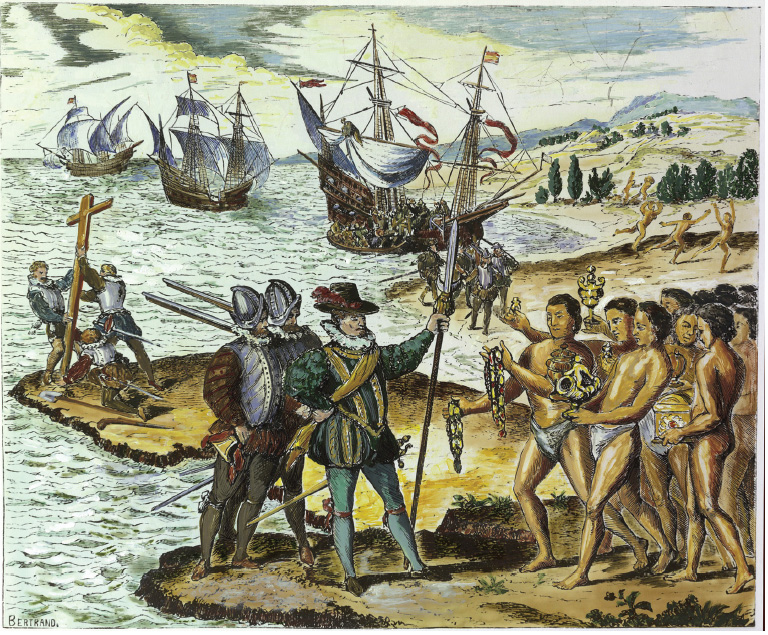The first meeting of Columbus and his Spanish explorers with the natives of the Caribbean was one to be remembered. Posterity has pictured this scene as one of happy explorers sharing food with the natives; but the truth of that first encounter, and its aftermath for the natives, was far from happy. Through the exchange, the natives received a number of diseases for which they had no immunities; and one of the largest demographic disasters the world has ever seen was the result. But the disease syphilis was also exchanged, between the New World and the Old World. The nature of this exchange of syphilis, though, is full of debate and speculation concerning its origins.

Syphilis was one of the most notable examples of New World diseases that traveled to the Old World in what historians now call the Columbian Exchange. There are two different theories for how syphilis was spread. The Columbian hypothesis claims that syphilis was spread by Columbus and his crew on their voyage back to the Old World. Once they contracted it from natives in the Americas, the crew then went back to the Old World. The evidence that supports this hypothesis is the assumption that Columbus’s crew members, once returned back to Spain, joined Spain’s war effort in Naples, exposing the disease to local prostitutes. Once exposed to syphilis, the disease was spread quite easily from the prostitutes to other soldiers and locals, thus increasing the spread of syphilis in the Old World. This explanation for the spread of syphilis is possible because some of Columbus’s crew did in fact join the war effort against Naples and most likely they did mingle with the locals there causing the spread of syphilis.1
The other theory, the Pre-Columbian hypothesis, was that syphilis had always been an Old World disease, but its spread was only exacerbated through the interaction of the natives and Europeans during the Columbian Exchange. This second theory is plausible since there is evidence of pre-Columbian Old World skeletons that show scars similar to syphilis scars. What this means is, since the skeletons from the Old World have scars and written accounts of symptoms similar to syphilis that pre-date the first exchange between Columbus and the Americas, syphilis could have possibly been an Old World disease. Now this theory of syphilis’ origin is a matter of syphilis being yet another disease that was spread from the explorers. Both of these hypotheses are plausible.2
Although these two theories for the origin of syphilis have been debated for decades, a less know third theory has emerged. This third theory suggests that syphilis was both an Old World and a New World disease. Syphilis is thought to “evolved simultaneously with human.”3 In other words, when the respectively different populations of humans evolved, the disease known as syphilis grew with the population in both hemispheres. This theory, though, is mostly unknown because of the two older and more established theories, which have dominated the discussions on syphilis’ origins. This third theory puts an interesting twist on this long debate.4
Through the exchange of syphilis, the lives of natives and explorers were changed in a drastic way. The picture of happy natives and explorers sharing food is one everyone has seen but the different narrative of the debate of syphilis’ origins is one many have not seen. The three theories of syphilis are all very real and possible, which is why the debate of syphilis is such a topic that can cause arguments. The debate over syphilis’ origins is one that will most likely be researched and hypothesized over for many years to come.
- Nathan Nunn and Nancy Qian, “The Columbian Exchange: A History of Disease, Food, and Ideas,” The Journal of Economic Perspectives 24, no. 2 (2010): 166-167. ↵
- Nathan Nunn and Nancy Qian, “The Columbian Exchange: A History of Disease, Food, and Ideas,” The Journal of Economic Perspectives 24, no. 2 (2010): 167. ↵
- Brenda J. Baker et al., “The Origin and Antiquity of Syphilis: Paleopathological Diagnosis and Interpretation and Comments and Reply,” Current Anthropology 29, no. 5 (1988): 703–706. ↵
- Brenda J. Baker et al., “The Origin and Antiquity of Syphilis: Paleopathological Diagnosis and Interpretation and Comments and Reply,” Current Anthropology 29, no. 5 (1988): 704. ↵



53 comments
Ana Gonzalez
What an interesting article! Diseases are known to mutate and are capable of adapting to different environments with different climates, and organisms. So whether Syphilis began in the Old World or in the New World, the disease was able to travel across the ocean and infect people from both sides. It is interesting how the Spaniards were able to wipe out thousands of natives with the diseases they brought. Great article!
Gabriela Medrano
I do not know much on the subject but the information provided and sources used were credible. The first two theories in this article are of more related context, however I felt the third one was placed in an odd section. Yet, the last theory has a good point; I do not see why the disease should originate from a single source and could be a mutation within the human body. Throughout the course of history I believe more and more theories will rise and with the advancement of technology researchers will find a definite answer. All together the article was good, very insightful, and it strongest points were well conveyed.
Tina Valdez
I know very little about the origin of many of the diseases that took many lives in history therefore I certainly was unaware of the amount of theories there are in regard to the origin of syphilis. The third theory you described is the one I found most interesting. I believe this theory might consider a couple of thing that the two more established ones may not, however it would take a considerable amount of research to identify them effectively. Great article!
Edelia Corona
Although you gave some interesting arguments on the two other theories, I think I agree more with the Pre- Colombian Hypothesis. In school we were taught that Native Americans from the New World contracted many diseases from the Old World. It would not be too much of a stretch to assume the Natives also contracted Syphilis. Also, the skeletons and symptoms that were recorded are pretty persuasive. Thank you for sharing this article, it was very interesting and made good points.
Christian Lozano
Wow, I did not know the diseases were spread through the prostitutes, how sad. It is very interesting to see how these different theories attempt to explain the origins of Syphilis, Great Article. Keep it up!
Karissa Aguilar
This is one of those articles that make me think of a topic that I had never even considered until now. It’s crazy how we have so many different diseases but we rarely think about where and how they originated. I had no idea that there were several theories as to how this disease inhabited, but it only makes sense since it wasn’t known back then. I loved how you didn’t just focus on one theory, but presented several, and left it up for discussion.
Andres Palacios
Incredible how this disease affected the lives of many. As I read in other articles Trade routes and exchanges are the main cause of the spread of this diseases like syphilis, black death, small pox, and measles. This affected greatly the health of many Europeans and Natives and it took many lives since at the time there wasn’t a cure our a way to treat this diseases.
Jezel Luna
The theory I remembered about Syphilis was connected to Columbus and his crew members. However, I was not aware of how it was exacerbated with the interaction of natives and Europeans. This disease has been around for so long, yet we are still debating where it originated. Very informative article!
Aylin Salinas
Wow, I had heard/read about the first two theories of the coming of Syphilis but never the third. I really quite agree with the third one. Both groups of people involved had millions of diseases unknown to the other. We will not be able to pin point who was the originator of syphilis, but it’s crazy to think that it’s been around for so long!
Rafael Ortiz Salas
This article was really informative, I knew some about the Columbus exchange containing diseases but I never knew it had syphilis. I really enjoyed this article it was well organized and clear, and also because I learned something new.